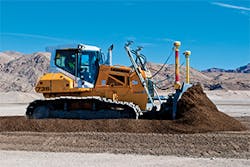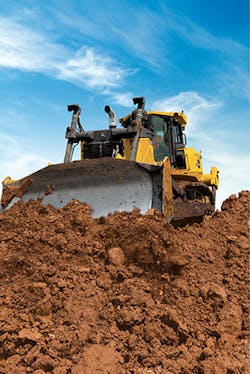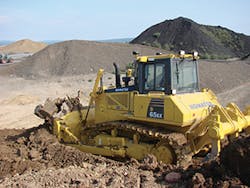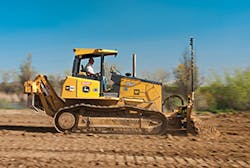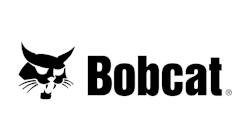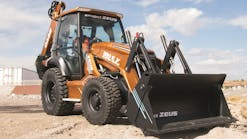When you think of dozers, you think of strength and power, and rightly so. They are the machines that have, literally, moved mountains, and you’ll find them in most contractors’ fleets of construction equipment. They tend to be the first machines running when a site must be cleared and flattened for a new housing development, or at the site that breaks through old ground to start a new road or highway. Dozers are powerful, reliable machines for earthmoving. The challenge is: Do we use them for all the jobs they can do, or are we stuck in thinking they can only shift earth, soil, or sand?
One feature that struck me as most practical and time-saving on the John Deere 1050K crawler dozer, introduced early this year, was the hydraulic power-pitch option that allows the operator to control blade pitch from the cab. The blade pitch is also adjustable to three mount locations for better performance in different materials and applications. The programmable return-to-pitch settings allow the operator to preset blade-pitch positions, which can be activated by the push of a button. Time-saving, performance-enhancing features like this on a dozer are true advantages, but the operator must know about them and how to use them! Beware the worker who claims he can drive anything without any training or instruction, because he’s been doing it for so many years! (Unfortunately, he’s often been doing it inefficiently for those many years and costing his employer unnecessary money.) New dozers have new capabilities and operators need to know them . . . or you’ve wasted your money.
That 1050K crawler dozer just mentioned is the most powerful dozer ever built by John Deere. The design and manufacture used extensive customer input before completion, so that the dozer would have the reliability, durability, and productivity to make it valuable in quarrying, road building, mining, and many large-scale applications. “Customer feedback was vital in developing this game-changing dozer,” explains Mark Oliver, crawler dozers product marketing manager at John Deere Construction & Forestry. “The 1050K is a new generation of crawler dozer that provides the uptime, low daily operating costs, and productivity needed on today’s job site. It is a Deere-designed machine that is fully supported by John Deere dealers and it’s unlike any crawler dozer our customers have ever seen in this size class.”
This dozer has an EPA Final Tier 4/EU Stage IV Powertech diesel engine offering 350 hp. The redesigned dual-path hydrostatic transmission allows an operator to push a full load through turns without losing material, unlike some torque-converter transmissions on competitive machines. If an operator is aware of this feature, loads can be bigger, and jobs can be completed more quickly. To repeat, your operator must know about the capabilities of the dozer to have it performing at its best. Like a smaller dozer introduced recently by John Deere in the K Series (the 850K) the 1050K has the Eco mode, a feature that gives better fuel economy while maintaining ground speed. It adjusts the engine speed and transmission settings automatically, based on load, which gives the dozer the potential to reduce fuel consumption by as much as 25% in many applications with no loss in productivity.
Before starting work at the job site, operators of John Deere 1050K dozers can set the maximum desired ground speed, while the power management system will automatically maintain peak engine rpm and power efficiency without shifting or stalling. The joystick provides intuitive, low-effort control of steering, direction, and ground speed. The exclusive Total Machine Control (TMC) monitor lets the operator select decelerator mode and response: forward/reverse ground speed ranges, steering modulation, F-N-R shift rate, and forward/reverse speed ratios. But yes . . . you knew I’d say this again . . . the operator must know aboutthese capabilities for the dozer to do its best—and give you your best results.
John Deere Crawler Dozer
At the other end of the dozer scale, there is a machine known as a “trail dozer”. It makes trails and has been successful for projects in such activities as walking and hiking through woods and parks, used by owners like municipalities, counties, states, and federal agencies. It makes new trails for the community, does maintenance work, helps ranchers and contractors in land clearance, and has performed frequent residential work. Manufacturer Sutter Equipment Co. offers the 300 Mini Dozer and the 500 Trail Dozer. The 300 can build about 1,000 feet an hour of 30-inch wide single-track trail. It can go uphill with ease and manage rolling dips readily. The manufacturer says that the 300 Dozer pays for itself in one season when you consider the savings in labor alone. The Sutter 500, with a 4-cylinder Mitsubishi Tier 3 diesel engine, offers 83 hp at 3,000 rpm. It uses, on average, 1 gallon of fuel per hour. The Angeles National Forest in Arcadia, CA reported: “We had $75,000 and three months budgeted to finish the last 7.5 miles of the Pacific Crest Trail and we finished it in eight days at a cost of less than $8,500 with our Trail Dozer.” (There’s a great video of the machine in action on YouTube. I was amazed at the size of some of the boulders it shifted easily.) What these small dozers may inspire is the thought that there are many local tasks they could manage. It would simply take somebody to realize the potential of such workhorses—and the comparative savings in equipment and labor, if they were used in preference to more traditional methods of making trails, paths, and walkways, which residents and tourists are asking for more frequently than ever.
Another area where dozers can be a huge help is in areas of fire control. Not as widely broadcast or praised as other equipment and people in fighting forest and prairie fires, dozers and their operators have done great work in pushing back and shepherding flames and burning branches in many parts of the country. The powerful embrace of the dozer’s blade, even smaller models, has pushed away dangerous, burning trees and bushes to let them burn where they will not spread the dangers. Even when there’s no fire and land must be cleared for new property development, dozers have led the way. Trees, shrubs, bushes, buildings, and all kinds of undergrowth can be removed by a dozer, thanks to its power—and the control the operator has over where the uprooted and demolished debris are placed.
This older model Komatsu dozer manages well in difficult ground
Control Inside the Dozer Itself
The first of Liebherr’s Generation 6 dozers to be introduced to the North American market is the PR 736; there will be two larger models later. The PR 736 has an operating weight of 44,750–54,230 pounds and a blade capacity of 5.36–7.27 cubic yards. This dozer can have a six-way blade option to make it ideal for material moving, creating embankments, filling up trenches, and finish grading. Among the appealing features of this dozer are the Liebherr electronic and machine control systems, integral parts of the machine. The electronic control management system monitors the load condition on the dozer and operator commands to adjust the drive train in the most appropriate way. This control includes the motors, engine power, and variable pumps. It’s a fully automatic process controlled by the Liebherr built-in electronics; the operator probably notices nothing but the good pushing performance and outstanding fuel efficiency. The cab design of Liebherr dozers also contributes significantly to their productivity (and safety). They offer outstanding visibility and have all the instruments and operating controls organized for efficiency within easy reach. They have a single lever control so that all driving functions can be managed smoothly with only one operating lever (including that “turning on the spot” function). As automatic two dimensional (2D) and three dimensional (3D) machine control systems become essential for enhancing productivity, Liebherr’s stepless drive concept means its dozers are ideal for this type of machine control. You can get factory-installed preparation kits for all common system suppliers to allow owners the maximum flexibility when they select the control system that best meets their needs. Again, to take advantage of these dozer advantages the operator must be aware of them and trained in their use.
It was the blade and its versatility that seem to have inspired the D61EXi/PXi-23 dozers from Komatsu. It’s the first intelligent machine control Komatsu dozer for North America. It can give you finish grading and rough dozing, to produce superior productivity. “We were excited to bring to market the next generation of machine control technology with Komatsu’s intelligent Machine Control D61i-23,” notes Peter Robson, director of intelligent machine controls. “The ease with which the D61i transitions from rough dozing to finish grading with automatic blade control engaged is so seamless that both experienced and inexperienced operators will notice benefits.” Customers can choose longer track-on ground standard (EX) and low ground pressure (PX) models to suit their applications. Operating weights go from 39,441–41,381 pounds, depending on configuration, with a net 168 hp at 2200 rpm. This dozer also offers the integration of Komatsu’s proprietary KOMTRAX (Komatsu Machine Tracking System) and Topcon’s construction management system. When it’s rough dozing, the automatic blade control monitors the blade load and adjusts the elevation to minimize track slip, allowing high efficiency dozing. As the work advances, becoming closer to the target finish grade, the automatic blade control adjusts accordingly to provide finish grade performance with great precision. Komatsu says the rough dozing efficiency is as much as 13% better than for dozers using add-on machine control systems. “The innovation is not only that Komatsu can provide the customer with fully automatic blade control for automatic rough dozing and efficiency improvement,” says Robson. “Komatsu can offer this technology while maintaining finish grade performance in the D61 dozer size class, which is one of the most popular size class dozers for machine control usage.”
Of great importance and practical value is that Komatsu has changed add-on machine control system components for the factory-installed cab top GNSS (Global Navigation Satellite System) antenna, enhanced the inertial measuring unit, and stroke-sensing hydraulic cylinders. These components, along with the machine control controllers and monitor mounted inside the cab are installed at the Komatsu manufacturing facility during the machine’s assembly. Robson explains further that the integrated sensor package, robust and accurate, eliminates the daily hassles of installing and removing GNSS antennae and cables from the blade, plus the wear associated with those procedures. When this dozer travels around the job site, the cab top GNSS antenna collects accurate surface data by measuring actual elevations. The stroke sensing angle cylinder measures the actual angle of the blade for high precision grading accuracy on a cross slope, with the blade angled or not. The D61i-23 crawler dozer also has the latest KOMTRAX technology. This sends machine operating information to a secure website using wireless technology. Hour meter, location, cautions, load ratio, fuel consumption, and maintenance alerts are among the features relayed to the web application of analysis. KOMTRAX has shown that it increases machine availability, reduces the risk of machine theft (contrasted with machines without KOMTRAX), allows remote diagnosis by the distributor, and provides more information to give the dozer owner better productivity and good business efficiency.
The changes in design and components for dozers like those from Liebherr and Komatsu remind us that not all advances come from extra products you add to the basic dozer, although some do. Some advances are built into the new models of dozers, with control systems installed at the factory and changes in control made from the cab. In the past, many changes and advances for construction equipment have meant extra labor, even additional equipment for mounting and dismounting added capabilities. Dozers have, indeed, come a long way in a relatively short time. Knowing the changes and progress will save us time and money onsite.
Blade control, provided here by Topcon, gives dozers excellent accuracy and speed
Enhancements to Add to Your Basic Dozer
Some of the best ways to improve performance and profitability for your dozer come from sources that do not make dozers. High on the list of such companies must be Topcon, Leica, and Trimble. Minimizing the amount of rework to be done is one benefit that means a lot to users of Leica’s GradeSmart 3D system, as rework is probably the most common and expensive procedure in dozing and grading that we would like eliminated. With this system, which can be operated in either an indicate or automatic configuration, the dozer operator has real time grade and project information with the cut and fill values clearly indicated or, in the automatic configuration, the Leica system will move the machine’s blade to the desired surface elevation, in real time. That elevation is based on the design model inside the onboard computer, which takes a lot of the hard work out of creating complex design surfaces.
The manufacturer points out that the GradeSmart system can be moved from machine to machine (even grader to dozer if that suits your current project). The older Leica 2D graders and dozer systems can be upgraded to GradeSmart 3D. The latest GNSS technology is used, to make the system most accurate and reliable and the system is compatible with a wide range of GPS/GNSS base station systems and Leica Total Stations. Among features emphasized by the manufacturer are the ability of this system to adjust for changes in mast position, to maintain accuracy with blade roll, and also the ability to hold the blade’s position constant across breaklines, so you can get better, more accurate cutting with crowns and batters. Add to that the automated control of the blade in lateral movement to give accurate edges and designs. All this accuracy achieved on the first pass is one reason that rework can be minimized or completely eliminated. There have been many applications where Leica’s GradeSmart 3D has been praised for its great results, including rough grading to finish grading, roads, highways, slopes, grades, embankments, commercial and residential site developments, airports, golf courses, and car parks. Those applications cover a lot of what contractors do, and may suggest a few new projects to some of you. We’re thinking of dozers mostly in this article, but systems like those from Leica can also benefit excavators, graders, concrete pavers, and asphalt machines.
Those three leaders I mentioned (Leica, Topcon, and Trimble) offer many systems, but I am choosing just a few to show how they can maximize the value of your dozer. The most obvious benefit is that you may need just your dozer, not your dozer and another machine, to prepare the ground for the next stage of construction. That means usually that you need only one employee for the job, rather than two, or even more if you count those who used to be needed for staking, etc. The obvious savings are in labor and time, but don’t discount the value of your company being able to achieve excellent results in better time than other methods.
If rework is the worst enemy of efficient earthmoving, the cost of idle time must rank almost as badly. It’s one of the benefits gained from using Topcon’s Tierra. This program is probably best described as a tracking system. Tierra enables GNSS tracking and monitoring of construction equipment, so that you can work with efficient equipment deployment and use as well as minimize losses from theft of equipment or unauthorized use. Tierra will monitor and manage excessive idling. (Why have we always called it idling? The engines are not idle. They are burning fuel. They may not be doing anything productive but they are still spending money.) Another, most practical and cost-effective benefit of the Tierra system is that it allows you respond to maintenance issues only when there is a need.
Another Topcon offering that has been widely used and praised for its helpfulness in dozing is the 3D-MC² system. It has been reported to increase speeds up to 200% over other 3D systems and its accuracy in smoothness and grading incomparable to that of motor graders. What that means is that one dozer can do the work that used to take two. At some sites, a dozer with Topcon’s 3D-MC² help will eliminate the need for grader and, with fewer passes required, it will mean more good work achieved in less time. Less time at one job means less machine wear and less fuel, but it also means the dozer can be working somewhere else and making you money in the saved time. For the technically-minded of you, 3D-MC² uses Topcon’s GX-60 control box, GNSS antenna, MC-R3 receiver and a new sensor, all paired with advanced new controlling software to provide position updates up to 100 times per second. The MC-2 sensor combines a gyro, compass, and inertial sensor to measure the X, Y, and Z position as well as the roll, pitch, yaw, and acceleration of the dozer.
Several Trimble products have been helpful in two projects I looked at, miles apart in the world but both examples of typical construction work anywhere in the world. For the new airport in China known as the Kunming WUJIABA International Airport, they are anticipating annual passenger numbers of 38 million per year by 2020. Trimble Site Positioning Systems and Machine Control Systems will be important players in this project. The Trimble GCS900 Grade Control System will be inside the cab for dozers, graders, and pavers to position equipment accurately, to reduce material overages, and improve site productivity. “On the dozer, the GCS900 can help produce a good surface at an adequate accuracy level, guided by GPS,” comments Bruce Zhang, technical support engineer with Trimble. “In this case it can save a lot of rework and it allows operators to reach base-level requirements much faster.” Constructing the two new 4,000 meter-long runways at the airport is one of the most critical components of the entire project.
When the school and rectory buildings of St. Richard’s Catholic School in Omaha, NE, closed in 2009 and were later scheduled for reuse as the site for 44 energy-efficient, handicapped accessible cottages requiring multiple-elevation building pads to comply with ADA requirements, subcontractor Heimes Corp., of Omaha won the contract for the site grading and all the sanitary pipe and paving work. There were challenges. “There’s about a 40-foot elevation drop from one to the other,” observes Chad Henry, grading superintendent at Heimes Corp. “We’re performing all the site prep and following the contour of this hill which follows a six-to-one slope. We removed the existing road, did the clearing and grubbing work. I believe we removed about 6,400 square yards of paving there before we started the site grading and pad work.” Heimes’ responsibility included creating the digital site plan, using Business Center–HCE. The software was reported to be essential to the data preparation for the Trimble machine control and site positioning used on the project. With its 3D digital plan in place, Heimes Corp. tasks include doing 25,000 cubic yards of cut-to-fill, 8000 cubic yards of export, installing approximately 13,000 linear feet of sanitary sewer, 15,000 feet of storm sewer, 2,000 linear feet of water main, and the excavation for two stormwater detention cells. “On every aspect of the grading operation, we used Trimble technology to help us complete our end of the project,” says Henry. “We were already using Trimble GCS900 Grade Control Systems with GPS on our dozers and soil compactor, and we upgraded our John Deere 764 HSD (high speed dozer) to the latest version with the new GradeMax technology for dozers.”
The company has been using construction technology since 2005; they felt comfortable comparing results of the Trimble systems. “GradeMax technology makes the Trimble system faster,” asserts Henry. “The processor seems to run quite a bit faster for changing offsets and changing designs, while the other great benefit is you can adjust your valve speed as you’re moving. The on-the-fly valve adjustment is probably the most impressive thing that I’ve seen. We’re able to save time when getting to accurate grade. Instead of making three test passes, you make one. By the time you’re done making your test pass, it’ll be adjusted to how you want it to be.”
Back to Square One?
There are, therefore, several good systems for getting best out of your dozer.
But some of the greater efficiency comes right with the dozer you bought. Let’s say you, like many other contractors, own a Caterpillar dozer. Is that it? It’s a dozer, it moves earth (and many other materials). Do you know, and does the operator know how to get greatly improved performance? Does your Caterpillar have AccuGrade GPS? AccuGrade GPS is a Caterpillar solution for those many projects when your construction site involves what we could call contours, ground where there are more than single or dual planes. The system uses GPS technology to compare the blade position to a 3D computerized site plan and signals the operator or hydraulic system to raise of lower the blade to achieve the design targets. It’s a system that doesn’t ignore the operator! Though it is described as a high technology machine control and guidance system, AccuGrade GPS lets dozer operators grade with greater accuracy (without the need for survey stakes). The digital design data, in-cab operator guidance features, and automatic blade controls help the operator to attain grade more quickly, and that means higher production rates, lower operation costs, and greater profitability. It can be successful for bulk clearing with high productivity to finish grading with tight tolerances. What kinds of projects benefit from this system? Roads, highways, parking lots—any flat, single, and dual sloping planar designs can benefit from being on-board, ready for the operator to proceed. Complex 3D designs, such as roads with super elevation and golf courses, can be created in the office by your design engineers and loaded in to the AccuGrade system via a compact flash card.
Who is using his dozer effectively? “Customers are very smart about using a machine to its fullest extent,” encourages Sam Meeker, Product Application Specialist, Track Type Tractor and Track Type Loader Applications, for Caterpillar. “With the grading capabilities of Cat dozers nowadays, many customers are finishing jobs without even using a motor grader. What we often find is that customers use machines successfully outside of their operation zone. They think moving stumps with a small dozer or even finish grading with a D8T! An excellent example of a contractor using a dozer today where the job used to be given to loaders or other equipment is finish grading with a D6K2, where a motor grader would have been the traditional solution. The dozer is the most efficient machine at pushing, and at working in soft underfoot conditions. These two conditions are met quite often on a job site.”
Road construction and renovation are projects in demand today. How important are dozers in those? Caterpillar’s Sam Meeker tells us the straightforward answer. “The dozer is the first machine on the job site, and often the last to leave. No machine does a better job at general clearing of land. Sometimes an excavatorhelps with the stumping, but the dozer is the primary land clearing tool. Soft underfoot conditions are challenging for many pieces of construction equipment, but the dozer is well equipped with tracks to spread the weight and provide traction. From the first clearing work to earthmoving, land forming, defining the road lanes, to spreading the base rock and finish grading, the dozer should be perceived as a critical piece of equipment for road construction.”
In Your Homework, Don’t Miss These!
While we had Sam Meeker of Caterpillar helping us, we put the following question. “What capabilities of newer dozers do operators tend to ignore, and therefore lose productivity?” The same question could be asked of any of the leading dozer manufacturers, like Komatsu, John Deere, Liebherr, and CASE. It is certainly worth asking of your favorite.
“We have focused many of our resources on equipment design to improve productivity and fuel efficiency,” explains Meeker. “Owners and operators can miss some critical and money-saving features, which can cost them in the long run. For example, the D3K2–D6K2 dozers from Cat have a fuel saving feature called ECO Mode. This feature automatically reduces engine throttle to save fuel during low load situations, such as finish grading. If the machine encounters a heavy load, the throttle is automatically restored to full power, giving the dozer plenty of power to push the heavy load. Then, when the load is lightened, the throttle is reduced back to its more efficient lower rpm level. This feature alone give 5–20% fuel savings for a typical contractor. Operators can choose this mode by turning the throttle dial to the ‘green zone’ on the dial. It’s an easy way to save money on fuel, with no degradation of performance. This same functionality is available on the D6T, D7E, and D8T Tier 4 Final tractors, using Enhanced AutoShift. (Again, look for the green on the throttle dial.)”
AutoShift is a new transmission program that gives the operator the choice of a 3-speed, 6-speed, or 9-speed machine, using the transmission and throttle to vary machine ground speed. By providing more speeds in the working range, the user not only improves productivity by pushing faster, but also reduces fuel consumption in lighter loaded applications. (Yes, check the green zone on the throttle.) A final feature to mention is Cat’s StableBlade, which creates a smoother finish at a faster speed than machines without the feature. It uses electronics to help smooth out the finish surface.
And here’s the last time to say it. All the features that can make your dozer so much more practical than being just a machine that pushes earth and sand as you always have—all these features and benefits depend on you, and the operator knowing they exist, and then knowing how to use them.
